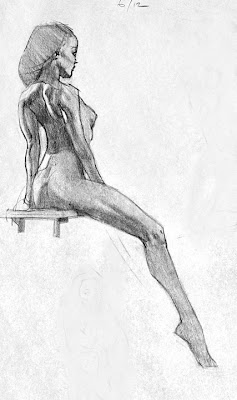When undertaking an art study such as life drawing, there are a few, not so obvious, but basic tips that help foment important habits that become a foundation for each new level of skill.
THE ALL IMPORTANT PENCIL.
The experience of sketching and drawing the human figure has many components. The most basic tool is the pencil. Graphite or charcoal each have their properties and characteristics. Each one ideal in specific situations.
 Graphite is easier to control and, for most people, gives a certain confidence. It doesn't powder, is less messy and can be sharpened in a pencil sharpening device. It works beautifully in sketching out ideas and rough concepts in smaller sketchpads and is a terrific instrument for fine drawings. In a figure drawing class, where one is exploring value depths, very few graphite pencils can go truly black. If not careful with keeping a light touch and sharpening often, it can leave a reflective shine, flattening areas while also increasing the danger of slicking the drawing surface losing the texture of the paper underneath. The graphite pencil also encourages one to hold the tool always as a writing instrument with the wrist being the only radius to arc and pivot from.
Graphite is easier to control and, for most people, gives a certain confidence. It doesn't powder, is less messy and can be sharpened in a pencil sharpening device. It works beautifully in sketching out ideas and rough concepts in smaller sketchpads and is a terrific instrument for fine drawings. In a figure drawing class, where one is exploring value depths, very few graphite pencils can go truly black. If not careful with keeping a light touch and sharpening often, it can leave a reflective shine, flattening areas while also increasing the danger of slicking the drawing surface losing the texture of the paper underneath. The graphite pencil also encourages one to hold the tool always as a writing instrument with the wrist being the only radius to arc and pivot from.
Charcoal can leave charcoal marks on other than the paper, can flake off in the softer varieties, can be dusty and most often, must be sharpened with a razor. However, it creates a great matt line and rich dark values increasing the gamut in range of light to dark. Sharpening with a razor one can chisel a fine custom point and long side for a variety of marks. The point is for refined and delicate lines and the side is for laying in wide swatches of darker value. There is also a stronger sense of tack that is picked up from the paper when using charcoal. Texture from paper lends a bit of tactile feel that can slow a mark down for refinement or, with increased pressure, allow a bold, value layered swipe all in one stroke. The analogy towards painting is clearer in using the charcoal pencil as a brush with a point and a broad side
REFINED DRAWING MUSCLES
Drawing, also, requires a little bit of muscle training that directly influences how smooth the strokes you put down are. Drawing from the wrist, only, doesn't allow for complete freedom of an arm swing that places a nice fluid and clean gesture line on your paper. Holding the pencil as if holding a brush to paint begins the habit. The pencil is held underneath the hand, wrapping the fingers around it as if holding wand The thumb and index will hold it in place.
Drawing with the pencil held this way, in a life drawing class, allows the pencil to become a part of you, an extension of your arm. Experiment by creating a foot long arc on your paper using just your wrist or even pivoting from the elbow and then again from the shoulder. The freedom of the stroke will be unencumbered in the latter. Drawing from the shoulder also trains you to sweep the strokes in a painterly manner. Also, it exercises hand/eye coordination, where later one is using a brush that is longer than a pencil.
Drawing can be an end to itself or part of a deeper experience and foundation that carries over seamlessly into painting. In any case, it is an avenue of expression that opens the creative doors and enriches the spirit.

